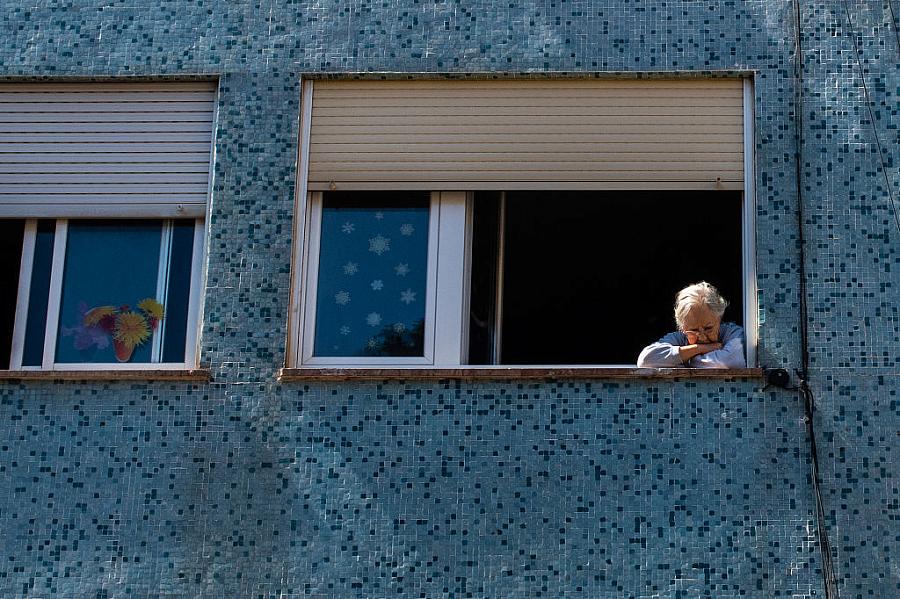Experts share insights on loneliness and isolation among seniors during COVID-19

(Getty Images)
Before the pandemic, a patient in his 90s would routinely walk around his neighborhood for exercise, recalled Dr. Carla Perissinotto, a geriatrician and palliative care physician in San Francisco.
Now, he’s staying home, afraid of the unmasked people he might encounter. Along with the increased isolation, his legs are weaker, and he struggles to get out of a chair.
His story isn’t unusual as older adults nationwide are foregoing social interactions and experiencing more loneliness, Perissinotto said in a Center for Health Journalism “Covering Coronavirus” webinar this week. Those changes can lead to widespread and serious health impacts.
“The bottom line is really that loneliness and isolation are bad for our health,” she said.
Perissinotto joined New York Times columnist Paula Span and Laura Trejo, general manager of the Department of Aging for the city of Los Angeles, to explore the impact of loneliness and social isolation on older adults. They discussed how the pandemic has exacerbated the crisis, steps that can help ease their struggles and how journalists can cover these complex topics with sensitivity and nuance.
The pandemic is increasing loneliness
Studies have tied social isolation and loneliness to poorer health outcomes, including increased rates of heart disease, worsened diabetes, poor sleep and depression, and Alzheimer’s, said Perissinotto, an associate professor of medicine at the University of California, San Francisco. Perissinotto’s own landmark 2012 study found that loneliness in older adults can predict functional decline and death.
The pandemic is making the problem worse. Perissinotto and her colleagues are working on a Bay Area study examining its impact on 151 older residents. They started collecting data after the first shelter-in-place order.
At the beginning, they found 29% of older adults surveyed experienced frequent feelings of loneliness, which is on par with averages from national research, she said. As the pandemic stretched on, 51% of people reported their loneliness was worse.
Other interesting findings: the telephone was the most commonly used form of communication, with 79% of people reporting minimal or no video interactions. That’s particularly relevant since so many social programs and medical care has moved online.
“This makes us think about who’s being left out,” she said. “And are we making a mistake by moving everything virtual?”
Ensuring accessibility
Social isolation is one of the top priorities for the Department of Aging for the city of Los Angeles, said Trejo, the department’s general manager. So is making programs that seek to address it more accessible to the city’s diverse residents.
At the beginning of the pandemic, she asked native speakers of different languages to call a series of organizations older adults might need to access. Her goal was to find out what it would be like for non-English speakers who need these services.
“What we were trying to figure out: How to make sure that people were not falling through cracks in our safety net,” she said.
The callers found that accessibility would likely be a problem for some non-English speakers. As a result, the department increased efforts to make basic services available in their native language.
During the pandemic, the agency and its partners have experimented with creative ways to connect with older adults. Conference calls have provided a popular low-tech community connection. They’ve also reached out in “old school” ways including fliers and postcards. And meal delivery staff have sought to have short interactions from outsides seniors’ homes when dropping off food.
“We see people trying all kinds of ways to meet the need,” Trejo said.
Portray the complexity
Aging is an area that’s heavily researched but underreported, said journalist Span, who has written the New Old Age column for The New York Times since 2009 and teaches journalism at Columbia University. She often looks to research in academic journals as well as geriatric groups on Twitter and government reports.
As a journalist, she finds it reassuring to have so much solid information about this vast older population, from their physical and mental health to their tech skills.
“That helps protect us against the kind of squishiness I worry about when we do trend stories,” she said.
She finds researchers and geriatricians are often accessible and eager to chat about their findings.
While isolation and loneliness have worsened with the pandemic, it’s important to keep in mind that individuals have distinct experiences. If you’ve met one 85-year-old, you’ve met one 85-year-old, she cautioned, emphasizing the heterogeneity of seniors. It’s not as simple as saying that all elderly face increased loneliness. Older people often have resilience, which leads some to report less anxiety and depression than younger groups, she said, warning journalists from portraying seniors as a bunch of pathetic, lonely dependents.
“Older Americans have been through a lot and they know how to modulate their emotions,” Span said. “They have some experience in riding out hard times.”
For some, the biggest challenge of the pandemic may not be loneliness and isolation but a loss of purpose, which can be devastating for people accustomed to working, volunteering or caring for family members.
On the tech side, it’s also important to delve deeper. She also urges journalists to be particularly wary and insist on evidence when reviewing pitches about the latest robotic companion or app targeting seniors.
While some older adults aren’t using technology, others are “stampeding onto these video chat platforms,” she said. There’s room for more stories about elders adapting.
“I am warning against the overly large brush,” she said. “I would like us to portray elders in all of their complexity.”
**
Watch the full presentation here:

